Aloe Vera Nutritional Value: A Health Powerhouse
Let me show you everything to do with Aloe vera nutritional value. You see, Aloe vera is a nutritional powerhouse, offering a plethora of health-promoting components and everyone should know about these.
With its rich nutritional profile, Aloe vera is not only beneficial for the skin but also offers a range of internal health benefits when consumed.
Consult your doctor, healthcare provider or nutritionist if you want to take Aloe vera internally.
Aloe vera’s key constituents include:
- Vitamins: A rich source of vitamins A, C, and E, all potent antioxidants. It also provides essential B vitamins like B12, folic acid, and choline.
- Minerals: Contains vital minerals beneficial for various physiological functions.
- Enzymes: Enzymes in aloe vera aid digestion and reduce inflammation.
- Sugars: Beneficial polysaccharides promote skin health and cellular repair.
- Lignin: Enhances the skin’s absorption of other nutrients.
- Saponins: These compounds exhibit cleansing and antiseptic attributes.
- Salicylic Acids: Known for their anti-inflammatory and antibacterial properties.
- Amino Acids: Comprises essential amino acids that fortify skin health.
In this comprehensive “Aloe vera nutritional value” guide, we look deep into the heart of Aloe vera’s nutritional value so I can offer you a holistic understanding of this wondrous plant.
I have over 20 of these plants in my land and can attest to its powerful nutritional and healing abilities. Take a look below.

Disclaimer: This guide is for informational purposes only. We are not medical experts. Always consult with a healthcare professional before changing your diet or health routine.
Aloe Vera Leaves hold a Treasure Trove of Nutrients
Aloe vera, often called the “wonder plant,” has been a staple in traditional medicine for millennia. And for a good reason.
Native to the arid regions of North Africa and the Middle East, this succulent plant has now found its way into gardens and homes worldwide, including mine. I cultivate Aloe vera on my property, craft my own gel, and blend it into my smoothies, among other consumption methods. Below, I’ll share some innovative ideas for you to incorporate into your routine.
When you see below the powerhouse of nutrients it contains, you’ll understand why it is easy to fall in love with this plant.
Packed with a myriad of vitamins, minerals, enzymes, and amino acids, Aloe vera offers more than just its soothing gel for sunburns!

Aloe Vera Nutritional Value: The Components
Here’s a helpful table of Aloe vera’s nutritional value (source).
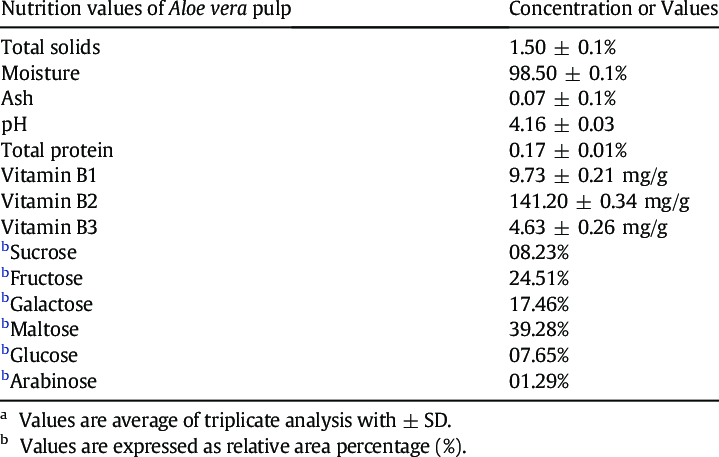
We will look at each component in depth below.
Vitamins in Aloe vera
Below, we take an in-depth look at each vitamin in Aloe vera. I’ve prepared a table that makes it easy to see, at a glance:
| Vitamins | Role | Aloe Vera’s Contribution |
|---|---|---|
| Vitamin A (Retinol) | Supports vision, immune system, and skin health | Present in trace amounts |
| Vitamin B1 (Thiamine) | Energy production, nerve function | Present in trace amounts |
| Vitamin B2 (Riboflavin) | Energy production, maintains healthy eyes and skin | Present in trace amounts |
| Vitamin B3 (Niacin) | Supports digestion, skin health, and nerve function | Present in trace amounts |
| Vitamin B5 (Pantothenic Acid) | Energy production, synthesis of coenzyme A | Present in trace amounts |
| Vitamin B6 (Pyridoxine) | Amino acid metabolism, red blood cell production | Present in trace amounts |
| Vitamin B9 (Folic Acid) | DNA synthesis, red blood cell production | Present in trace amounts |
| Vitamin B12 (Cobalamin) | Red blood cell formation, DNA synthesis, nerve function | Present in trace amounts |
| Vitamin C (Ascorbic Acid) | Antioxidant, collagen synthesis, immune support | Present in trace amounts |
| Vitamin D | Calcium absorption, bone health | Not a primary source in Aloe vera |
| Vitamin E (Tocopherol) | Antioxidant, supports immune function | Present in trace amounts |
| Choline | Cell membrane structure, neurotransmitter production | Present in Aloe vera |
And here’s a table that provides the Recommended Dietary Allowances (RDAs) or Adequate Intakes (AIs) for vitamins for adults:
| Vitamin | Recommended Daily Intake |
|---|---|
| Vitamin A | 900 mcg (men), 700 mcg (women) |
| Vitamin B1 (Thiamine) | 1.2 mg (men), 1.1 mg (women) |
| Vitamin B2 (Riboflavin) | 1.3 mg (men), 1.1 mg (women) |
| Vitamin B3 (Niacin) | 16 mg (men), 14 mg (women) |
| Vitamin B5 (Pantothenic Acid) | 5 mg (for adults) |
| Vitamin B6 (Pyridoxine) | 1.3-1.7 mg (for adults) |
| Vitamin B9 (Folic Acid) | 400 mcg (for adults) |
| Vitamin B12 (Cobalamin) | 2.4 mcg (for adults) |
| Vitamin C | 90 mg (men), 75 mg (women) |
| Vitamin D | 600-800 IU (depending on age) |
| Vitamin E | 15 mg (for adults) |
| Choline | 550 mg (men), 425 mg (women) |
Notes:
- mcg: Micrograms
- mg: Milligrams
- NE: Niacin Equivalents
- DFE: Dietary Folate Equivalents
- IU: International Units
- AT: Alpha-Tocopherol
Let’s now proceed to see each individual vitamin in Aloe vera.
Vitamin A
Vitamin A is a fat-soluble vitamin that plays a crucial role in vision, growth, cell division, reproduction, and immunity. It also has antioxidant properties, which means it helps neutralize free radicals in the body that cause tissue and cellular damage.
Benefits of Vitamin A:
- Vision: Vitamin A is essential for good vision, especially in low-light conditions. It forms a type of protein that absorbs light in the retinal receptors, aiding in night vision.
- Skin Health: It promotes healthy skin by producing and repairing skin cells. A deficiency can lead to dry, flaky skin.
- Immune System: Vitamin A supports the immune system by stimulating the production and activity of white blood cells, which play a crucial role in defending the body against infections.
- Growth and Reproduction: It is vital for proper cellular growth and forming the heart, lungs, kidneys, and other vital organs in embryos.
While Vitamin A has numerous benefits, consuming it in the right amounts is essential. Excessive intake can lead to toxicity, causing symptoms like dizziness, nausea, and even hair loss. It’s always recommended to consult with a healthcare professional to determine the right dosage for individual needs.
For a deeper understanding of Vitamin A and its benefits, you can refer to this scientific paper which discusses the stability and benefits of Vitamin A in cosmetic formulations.
Amount of Vitamin A in Aloe Vera:
While Aloe vera contains Vitamin A, it’s not its primary source. This vitamin is essential for vision, skin health, and the immune system. It’s always a good idea to incorporate various foods to ensure you get enough of this vital nutrient.
Vitamin B1 (Thiamine)
Vitamin B1, commonly known as thiamine, is a water-soluble vitamin that plays a pivotal role in converting food into energy. It’s essential for the proper function of the heart, muscles, and nervous system.
Benefits of Vitamin B1 (Thiamine):
- Energy Production: Thiamine helps our body cells convert carbohydrates into energy. It’s crucial for glucose metabolism and plays a key role in nerve, muscle, and heart function.
- Nervous System: It’s vital for the growth, development, and function of the cells in our body, especially nerve cells.
- Brain Function: Thiamine is required for the synthesis of neurotransmitters, which are chemicals that transmit signals in the brain.
- Antioxidant Properties: Thiamine has been observed to have antioxidant properties, which means it helps combat free radicals in the body that can damage cells and DNA1.
- Plant Health: While not directly related to human health, it’s interesting to note that thiamine is also vital for plants. It plays a role in their disease resistance, stress tolerance, and overall yield2. This highlights the universal importance of this vitamin across living organisms.
A thiamine deficiency can lead to beriberi, a condition characterized by weight loss, weakness, irregular heart rate, and neurological symptoms. In severe cases, it can lead to heart failure.
For a deeper dive into the benefits of thiamine, especially its role in neurodegenerative diseases, you can refer to this scientific paper1. Another study highlights the importance of thiamine in plant health and its potential benefits for food security, which can be accessed here2.
- Benefits of Thiamin (Vitamin B1) Administration in Neurodegenerative Diseases
- The importance of thiamine (vitamin B1) in plant health
Vitamin B2 (Riboflavin)
Vitamin B2, also known as riboflavin, plays a pivotal role in energy production and the metabolism of fats, drugs, and steroids. It also helps to maintain healthy skin, eyes, and nerve functions.
Benefits:
- Energy Production: Riboflavin is crucial for breaking down carbohydrates, proteins, and fats to produce energy.
- Maintains Healthy Skin and Eyes: It aids in maintaining the health of the mucus membranes in the digestive system and promotes good vision and healthy skin.
- Nerve Function: Vitamin B2 helps in the development and function of the skin, lining of the digestive tract, blood cells, and other vital organs. It’s essential for growth and red blood cell production.
A study titled “Associations of Milk Consumption and Vitamin B2 and B12 Derived from Milk with Fitness, Anthropometric and Biochemical Indices in Children” highlighted the significance of Vitamin B2. The key roles of these B vitamins in substrate oxidation, energy production, haemoglobin synthesis, and erythropoiesis could provide a basis for interpreting these associations.
However, it’s essential to note that while Aloe vera contains Vitamin B2, the exact concentration can vary based on the preparation and processing methods.
Vitamin B3 (Niacin)
Vitamin B3, commonly known as niacin, is a water-soluble vitamin that plays a vital role in the conversion of food into energy. It’s essential for skin, nerves, and digestive system health.
Benefits:
- Energy Production: Niacin is crucial for converting dietary carbohydrates, fats, and alcohol into energy in the body. It aids in the formation of ATP, the primary energy molecule in our cells.
- Skin Health: Niacin helps maintain the structure of the skin barrier, which is essential for hydrated, healthy-looking skin. It can also reduce inflammation and redness in the skin.
- Digestive System: Niacin assists in the production of stomach acid, aiding in the digestion process.
- Nervous System: It plays a role in nerve function and can help maintain the health of the nervous system.
A study titled “Vitamin B3 Provides Neuroprotection via Antioxidative Stress in a Rat Model of Anterior Ischemic Optic Neuropathy” highlighted the neuroprotective benefits of Vitamin B3. The research found that Vitamin B3 supplementation preserves vision by reducing oxidative stress, neuroinflammation, and mitochondrial apoptosis.
Another research titled “A dermocosmetic formulation containing Vichy volcanic mineralizing water, Vitreoscilla filiformis extract, niacinamide, hyaluronic acid, and vitamin E regenerates and repairs acutely stressed skin” emphasized the benefits of niacinamide (Vitamin B3) in skin health. The study showed that a niacinamide formulation significantly accelerated skin renewal and showed antioxidant defence activity, especially after exposure to stressors like UVA and cigarette smoke.
It’s important to note that while Aloe vera contains Vitamin B3, the exact concentration can vary based on the preparation and processing methods.
Vitamin B5 (Pantothenic Acid)
Vitamin B5, commonly known as Pantothenic Acid, is a water-soluble vitamin that plays a pivotal role in energy production. It’s essential for the metabolism of carbohydrates, proteins, and fats. This vitamin also aids in synthesising coenzyme A (CoA), which is crucial for various biochemical reactions in the body.
Benefits:
- Energy Production: Vitamin B5 is vital for converting food into energy. It supports the metabolism of carbohydrates, proteins, and fats, ensuring that our body gets the energy it needs1.
- Synthesis of Coenzyme A: CoA is essential for many biochemical reactions, including the synthesis and degradation of fats, the production of steroid hormones, and the maintenance of healthy skin1.
- Supports Healthy Skin: Pantothenic acid is often included in skincare products due to its moisturizing properties. It can help improve skin hydration and reduce the appearance of fine lines and wrinkles2.
Aloe Vera’s Contribution: Aloe vera contains trace amounts of vitamin B5, which can contribute to the overall intake. However, it’s essential to note that while Aloe vera can provide some B5, it shouldn’t be solely relied upon as the primary source. Consuming a varied diet is always recommended to ensure adequate intake of all essential nutrients.
Sources:
- Pantothenic acid and Coenzyme A in Health and Disease
- The role of vitamins and minerals in hair loss: a review
Vitamin B6 (Pyridoxine)
Vitamin B6, also known as pyridoxine, is a water-soluble vitamin that is essential for various physiological functions. It plays a pivotal role in amino acid metabolism, neurotransmitter synthesis, and hemoglobin production.
Benefits:
- Amino Acid Metabolism: Vitamin B6 is involved in the metabolism of amino acids, which are the building blocks of proteins. It helps in the breakdown and utilization of these amino acids for energy and other bodily functions.
- Neurotransmitter Synthesis: Pyridoxine is crucial for the synthesis of neurotransmitters like serotonin, dopamine, and gamma-aminobutyric acid (GABA). These neurotransmitters are vital for mood regulation and nerve communication.
- Hemoglobin Production: Vitamin B6 aids in the production of hemoglobin, a protein in red blood cells responsible for transporting oxygen throughout the body.
- Immune Function: It supports the immune system by promoting the health of lymphoid organs where immune cells are produced.
A study titled “Vitamin B6 and Its Role in Cell Metabolism and Physiology” delves into the multifaceted roles of Vitamin B6 in cellular metabolism and physiology. The research underscores the importance of Vitamin B6 in amino acid metabolism, lipid metabolism, and its influence on various diseases when deficient.
Another research titled “Vitamin B6: A Challenging Link between Nutrition and Inflammation in CVD” highlights the potential anti-inflammatory properties of Vitamin B6. The study suggests that adequate levels of Vitamin B6 might be protective against chronic conditions like cardiovascular diseases due to its role in reducing inflammation.
While Aloe vera contains Vitamin B6, the specific concentration can differ based on the source, preparation, and processing methods.
Vitamin B9 (Folic Acid)
Folic acid, also known as vitamin B9, is a water-soluble vitamin that plays a crucial role in DNA synthesis and repair. It’s also vital for the production of red blood cells and aids in the conversion of food into energy.
Benefits:
- DNA Synthesis and Repair: Folic acid is essential for the body to produce and maintain new cells, especially during rapid cell division and growth, such as in pregnancy and infancy1.
- Red Blood Cell Production: It aids in forming red blood cells, preventing anaemia, a condition where the body lacks enough red blood cells to carry oxygen to its tissues1.
- Neural Tube Defect Prevention: Adequate intake of folic acid during pregnancy is crucial as it helps prevent major birth defects in the baby’s brain and spine2.
Aloe Vera’s Contribution:
Aloe vera contains folic acid, making it a beneficial supplement. However, it’s essential to note that while aloe vera can contribute to one’s intake, it should not be the sole source. Incorporating various foods rich in folic acid, such as leafy greens, fortified cereals, and legumes, is recommended.
Sources:
- Food supplements to complement brain functioning
- Intended and Unintended Benefits of Folic Acid Fortification
Vitamin B12 (Cobalamin)
Vitamin B12, also known as cobalamin, is a water-soluble vitamin that plays a pivotal role in the normal functioning of the brain and nervous system. It is also involved in the formation of red blood cells and helps with DNA synthesis and regulation. Vitamin B12 is crucial for the metabolism of every cell in the human body, especially affecting DNA synthesis and regulation, as well as fatty acid and amino acid metabolism1.
Benefits of Vitamin B12:
- Neurological Function: Vitamin B12 is essential for maintaining the health of the nervous system, including the brain. It helps synthesise neurotransmitters, facilitating communication between nerve cells and playing a role in mood regulation1.
- Red Blood Cell Formation: It helps produce red blood cells, which carry oxygen throughout the body. A deficiency in B12 can lead to anaemia, a condition where the body does not have enough red blood cells to transport oxygen to vital organs1.
- DNA Synthesis: Vitamin B12 plays a crucial role in DNA synthesis and repair, ensuring the proper function and replication of cells1.
- Bone Health: Adequate levels of B12 are associated with healthy bone density, and a deficiency can lead to osteoporosis, where bones become fragile and prone to fractures1.
- Eye Health: Regular intake of vitamin B12 can potentially reduce the risk of age-related macular degeneration, a common eye disorder in the elderly1.
Aloe Vera’s Vitamin B12 Content:
While Aloe vera is often touted for its many health benefits, it’s essential to note that it is not a significant source of vitamin B12. Aloe vera can be a supplementary source, especially for those who follow vegetarian or vegan diets, like myself. It’s always recommended to consult a healthcare professional to ensure adequate vitamin B12 intake, especially if relying on plant-based sources2.
- Co-cultures of Propionibacterium freudenreichii and Bacillus amyloliquefaciens cooperatively upgrade sunflower seed milk to high levels of vitamin B12 and multiple co-benefits
- Cross-Sectional Study of the Prevalence of Cobalamin Deficiency and Vitamin B12 Supplementation Habits among Vegetarian and Vegan Children in the Czech Republic
Vitamin C (Ascorbic Acid)
Vitamin C, often referred to as ascorbic acid, is more than just the vitamin we associate with citrus fruits and fighting off colds. It’s a vital nutrient that our bodies need daily, playing a role in everything from skin health to immune function.
Found naturally in various fruits and vegetables, and also in supplements, Vitamin C is a powerful antioxidant that helps protect our cells from damage. Its multifaceted benefits make it a staple in our daily nutrition, and its presence in Aloe vera adds another layer to the plant’s health-promoting properties.
Benefits:
- Antioxidant Properties: Vitamin C is renowned for its antioxidant properties, which help combat free radicals in the body, potentially reducing the risk of chronic diseases1.
- Collagen Production: It aids in producing collagen, a protein necessary for healthy skin, cartilage, tendons, ligaments, and blood vessels.
- Iron Absorption: Vitamin C enhances the absorption of iron from plant-based foods, ensuring that our bodies get the necessary iron.
- Immune Support: It is crucial in supporting the immune system and aids in wound healing2.
How much Vitamin C does Aloe Vera have?
Aloe vera contains Vitamin C, contributing to its antioxidant and immune-boosting properties. Including aloe vera in your diet can help you benefit from the various functions of Vitamin C.
Sources:
- Sources and benefits of vitamin C
- Perceived Benefits and Intakes of Protein, Vitamin C and Iron in Preventing Anemia among Pregnant Women
Vitamin D (Cholecalciferol)
Vitamin D, often dubbed the “sunshine vitamin,” is unique because it can be produced in the skin from exposure to sunlight. It’s essential for strong bones as it helps the body use calcium from the diet. Traditionally, vitamin D deficiency has been associated with rickets, a disease in which the bone tissue doesn’t properly mineralize, leading to soft bones and skeletal deformities. But increasingly, research is revealing the importance of vitamin D in protecting against a host of health problems.
Benefits in the Body:
- Bone Health: Vitamin D plays a pivotal role in calcium absorption in the gut, which is necessary for maintaining healthy bones and teeth.
- Supports Immune System: It’s also crucial for modulating the immune system and inflammatory response, which can help reduce the risk of chronic diseases.
- Mood Regulation and Brain Health: There’s some evidence that vitamin D can regulate mood and ward off depression. It’s also been found to be key in maintaining brain health as we age.
- Supports Diabetes Management: There’s emerging evidence that vitamin D might play some role in insulin regulation and the management of diabetes1.
- Heart Health: Vitamin D may play a role in heart health and influence the regulation of cholesterol levels in the blood2.
Presence in Aloe Vera:
While Aloe Vera is not a primary source of Vitamin D, it’s essential to ensure you’re getting this vital nutrient from other dietary sources, sunlight, or supplements. Regularly consuming Aloe Vera in conjunction with a balanced diet can complement the benefits of Vitamin D.
Sources:
- Non-Musculoskeletal Benefits of Vitamin D beyond the Musculoskeletal System
- Is There Proof of Extraskeletal Benefits From Vitamin D Supplementation From Recent Mega Trials of Vitamin D?
Vitamin E (Tocopherol)
Vitamin E is a potent antioxidant renowned for its ability to combat oxidative stress by neutralizing free radicals. These free radicals can damage cells, leading to premature ageing and various health issues. Vitamin E also affects immune function, skin health, and vision.
Benefits:
- Antioxidant Properties: Vitamin E helps protect cells from the damage caused by free radicals, which are harmful compounds produced during the breakdown of food or when exposed to tobacco smoke and radiation1.
- Skin Health: It aids in skin repair and wound healing and protects against UV radiation. Many skincare products contain vitamin E for their moisturizing and healing benefits1.
- Supports Vision: Vitamin E may help reduce the risk of age-related macular degeneration, a common cause of blindness in older adults1.
Aloe Vera’s Contribution:
Aloe vera gel contains vitamin E, making it a beneficial addition to skincare routines. When applied topically, aloe vera can enhance skin hydration and provide antioxidant protection. However, for dietary sources of vitamin E, it’s essential to incorporate a variety of foods like nuts, seeds, and green leafy vegetables.
Source:
Choline
Choline is an essential nutrient that plays a crucial role in various bodily functions. It’s vital for maintaining the structural integrity of cell membranes, aiding in the production of neurotransmitters, and supporting metabolism.
- Cell Membrane Structure: Choline is a component of phosphatidylcholine, a molecule essential for forming cell membranes. This ensures that our cells function properly and can communicate with each other.
- Neurotransmitter Production: Choline is a precursor to the neurotransmitter acetylcholine, which is involved in many functions, including muscle movement and memory. Adequate choline levels support optimal brain function and cognitive processes.
- Metabolism and DNA Synthesis: Choline helps the body metabolize fats and plays a role in DNA synthesis. It also supports the liver in processing and excreting waste products.
- Pregnancy and Development: Ensuring adequate choline intake during pregnancy is crucial. Choline supports the developing fetus’s brain development, tissue expansion, and gene expression. Studies have shown that maternal diets supplemented with choline can improve several pregnancy outcomes and protect against certain neural and metabolic challenges1.
- Dietary Sources: While the body can produce choline in small amounts, obtaining it from dietary sources is essential to meet our needs. Foods rich in choline include eggs, beef liver, chicken, fish, and dairy products.
Aloe Vera’s Choline Content: Aloe vera contains choline, adding to its nutritional profile. While the exact amount can vary based on the specific aloe product or preparation, incorporating aloe vera into one’s diet can contribute to choline intake.
Source:
Minerals in Aloe vera
Aloe vera is not just rich in vitamins but also houses a variety of essential minerals that play crucial roles in our body.
Here’s a helpful table:
| Minerals | Role in the Body |
|---|---|
| Calcium | Development and maintenance of bones and teeth, muscle function, nerve transmission, blood clotting |
| Phosphorous | Bone and teeth formation, ATP production |
| Potassium | Muscle contractions, nerve impulses, fluid balance |
| Iron | Component of hemoglobin, energy production, metabolism |
| Sodium | Fluid balance, nerve transmission, muscle contractions |
| Magnesium | 300+ enzymatic reactions, metabolism of food, nerve impulses |
| Manganese | Bone formation, blood clotting, inflammation reduction |
| Copper | Production of collagen and elastin, energy production, metabolism of iron |
| Chromium | Enhances insulin action, metabolism and storage |
| Zinc | DNA synthesis, immune function, nutrient metabolism, wound healing |
Here’s a table stating daily mineral intake recommendation:
| Minerals | Recommended Daily Intake (Adults) |
|---|---|
| Calcium | 1000-1300 mg |
| Phosphorous | 700 mg |
| Potassium | 4700 mg |
| Iron | 8-18 mg (varies by gender and age) |
| Sodium | 1500-2300 mg |
| Magnesium | 310-420 mg |
| Manganese | 1.8-2.3 mg |
| Copper | 0.9 mg |
| Chromium | 20-35 µg |
| Zinc | 8-11 mg |
Calcium
Calcium is vital for the development and maintenance of strong bones and teeth. It also aids in muscle function, nerve transmission, and blood clotting. Aloe vera provides a source of calcium, which can be especially beneficial for individuals who don’t consume dairy. Reference
Phosphorous
Working closely with calcium, phosphorous is essential for bone and teeth formation. It also helps the body make ATP, a molecule the body uses to store energy Reference
Potassium
Potassium is a key player in muscle contractions, nerve impulses, and maintaining a healthy blood pressure. It also helps balance fluids in the body. Aloe vera offers a dose of this essential mineral. Reference
Iron
Iron is a component of hemoglobin, a protein responsible for transporting oxygen in the blood. It’s essential for energy production and metabolism. Aloe vera can be a supplementary source of iron, especially for those with certain dietary restrictions. Reference
Sodium
While sodium often gets a bad rap due to its association with high blood pressure when consumed in excess, it’s essential in small amounts. It helps maintain fluid balance, nerve transmission, and muscle contractions. Reference
Magnesium
Magnesium plays a role in over 300 enzymatic reactions in the body, including the metabolism of food, synthesis of fatty acids and proteins, and the transmission of nerve impulses. Reference
Manganese
Manganese is essential for bone formation, blood clotting, and reducing inflammation. It’s also involved in the metabolism of carbohydrates, amino acids, and cholesterol. Reference
Copper
Copper aids in the production of collagen and elastin, which maintain the strength of the skin. It also plays a role in energy production and the metabolism of iron. Reference
Chromium
Chromium enhances the action of insulin, a hormone essential to the metabolism and storage of carbohydrate, fat, and protein in the body. Reference
Zinc
Zinc is necessary for DNA synthesis, immune function, metabolism of nutrients, and the process of wound healing. It also supports growth during childhood and adolescence. Reference
Amino Acids in Aloe Vera
Aloe vera is renowned for its rich amino acid content, which plays a pivotal role in various bodily functions. Amino acids are the building blocks of proteins, and they’re essential for numerous biological processes, from muscle repair to neurotransmitter production.
Aloe vera contains 20 of the 22 human-required amino acids, making it a comprehensive source for these vital nutrients. More impressively, it boasts 7 of the 8 essential amino acids. Essential amino acids are those that the body cannot produce on its own and must obtain from dietary sources.
- Essential Amino Acids in Aloe Vera: These are amino acids that our body cannot synthesize, and we must obtain them from our diet. Aloe vera provides seven of these, making it a valuable dietary source for these crucial nutrients1.
- Non-Essential Amino Acids in Aloe Vera: These are amino acids that our body can produce on its own. However, having an external source can sometimes be beneficial, especially during times of illness or stress. Aloe vera contains 13 non-essential amino acids, further enhancing its nutritional profile1.
Amino acids play a myriad of roles in our body. They’re involved in building and repairing tissues, aiding in digestion, providing energy, and much more. The presence of these amino acids in Aloe vera underscores its potential as a holistic health supplement.
Source:
Sugars in Aloe Vera
Aloe vera is not only known for its soothing properties but also for its unique sugar content. These sugars, specifically the mono and polysaccharides, play a crucial role in the plant’s health benefits.
- Monosaccharides: These are simple sugars that serve as the building blocks for more complex carbohydrates. Aloe vera contains two primary monosaccharides: glucose and fructose. These sugars are essential for providing quick energy to the body.
- Polysaccharides: These are complex carbohydrates made up of chains of monosaccharides. The primary polysaccharides found in Aloe vera are glucomannans and polymannose. These polysaccharides are derived from the mucilage layer of the plant (between the outer leaf and the gel), which is why they are often referred to as mucopolysaccharides. They play a pivotal role in the plant’s healing and anti-inflammatory properties.
The presence of these sugars, especially mannose 6 phosphate, a significant sugar component, underscores the plant’s potential in various therapeutic applications. The sugars in Aloe vera contribute to its moisturizing, healing, and anti-inflammatory properties, making it a valuable ingredient in skincare and health products.
Fatty Acids in Aloe Vera
Fatty acids, which play a crucial role in the body, from supporting brain health to regulating the immune system.
In Aloe vera, you’ll find four specific steroids:
- Cholesterol: While often associated with negative health effects when present in high levels in our blood, cholesterol is essential for building cell membranes and producing hormones.
- Campesterol: This plant-based sterol can help in reducing cholesterol levels in the body.
- β-sitosterol: Known to support prostate health, reduce cholesterol, and boost immunity.
- Lupeol: This anti-inflammatory agent also possesses analgesic, antiseptic, and possibly anti-cancer properties.
These fatty acids, particularly the steroids, contribute to the plant’s anti-inflammatory and immune-regulating effects. For instance, β-sitosterol has been noted for its potential in supporting prostate health and reducing cholesterol levels1.
Additionally, lupeol, apart from its anti-inflammatory properties, has been recognized for its antiseptic and analgesic effects1.
Supplementary – Therapeutic Compounds: Beyond Nutritional Value
Aloe vera’s acclaim isn’t limited to its nutritional prowess alone.
The plant is a reservoir of compounds that, while not directly contributing to its nutritional profile, play a crucial role in its therapeutic and medicinal properties.
In the following sections, we’ll explore these special compounds, highlighting how they can benefit our overall health and well-being.
Anthraquinones in Aloe Vera
Aloe vera is known to contain 12 anthraquinones, which are phenolic compounds traditionally recognized for their laxative properties. Among these, Aloin and Emodin stand out for their analgesic, antibacterial, and antiviral activities.
- Aloin: This compound has been identified for its analgesic (pain-relieving) properties. It also exhibits antibacterial and antiviral effects, making it beneficial in treating various infections1.
- Emodin: Similar to aloin, emodin also acts as an analgesic and has both antibacterial and antiviral properties1.
It’s essential to note that while anthraquinones have therapeutic benefits, excessive consumption can lead to adverse effects due to their strong laxative properties. Always consult with a healthcare professional before making significant changes to your diet or health regimen.
Source:
Enzymes in Aloe Vera
Enzymes are biological catalysts that speed up chemical reactions in the body. Aloe vera, with its myriad of health benefits, also contains a variety of enzymes that contribute to its therapeutic properties.
Here’s a breakdown of the enzymes present in Aloe vera:
- Aliiase: This enzyme plays a role in the transformation of compounds within the plant, contributing to its unique chemical composition.
- Alkaline Phosphatase: Often associated with liver health, this enzyme can help break down proteins, making them easier for the body to digest.
- Amylase: A digestive enzyme that helps break down carbohydrates into simpler sugars, aiding in digestion.
- Bradykinase: This enzyme contributes to the anti-inflammatory properties of Aloe vera, helping reduce pain and inflammation when applied topically.
- Carboxypeptidase: Helps in the breakdown of proteins, further aiding in digestion.
- Catalase: An antioxidant enzyme that breaks down hydrogen peroxide, a harmful byproduct of metabolism, into water and oxygen.
- Cellulase: Aids in breaking down cellulose, a complex carbohydrate found in plants.
- Lipase: Helps in the digestion of fats, converting them into simpler compounds.
- Peroxidase: An enzyme that can help protect the body from oxidative damage by breaking down peroxides.
Aloe vera’s rich enzyme content underscores its potential as a holistic health supplement. These enzymes, combined with the plant’s other nutrients, make Aloe vera a potent superfood and therapeutic agent1.
Source:
Hormones in Aloe Vera
Aloe vera contains various plant hormones, with Auxins and Gibberellins being the most notable. These hormones play a pivotal role in plant growth and development.
Auxins are a group of plant hormones that are essential for plant body development. They regulate cell elongation, division, and differentiation. In the context of Aloe vera, auxins contribute to its renowned wound healing properties. When applied to wounds, auxins can stimulate cell division, leading to faster tissue regeneration and wound closure.
Gibberellins are another group of plant hormones found in Aloe vera. They are primarily known for promoting stem elongation and influencing certain developmental processes like germination, dormancy, and flowering. In Aloe vera, gibberellins, in conjunction with auxins, can enhance its anti-inflammatory effects, especially in wound healing.
It’s fascinating to note that these hormones, while naturally occurring in plants for their growth and development, can have therapeutic effects when applied externally on human skin. The presence of these hormones in Aloe vera underscores its multifaceted benefits, not just as a nutritional powerhouse but also as a therapeutic agent.
For more information into the therapeutic and pharmaceutical potential of Aloe vera, including its hormonal components, you can refer to this research paper.
Salicylic Acid, Lignin, and Saponins
Salicylic Acid: Salicylic acid is a plant hormone that plays a crucial role in the regulation of plant growth, photosynthesis, transpiration, ion uptake, and transport. In Aloe vera, salicylic acid has been identified and is known to contribute to its therapeutic properties1,2.
Lignin: Lignin is an organic polymer found in the cell walls of plants, giving them rigidity and strength. While it’s primarily known for its structural role in plants, in the context of Aloe vera, lignin enhances the penetrative effect of the other ingredients into the skin, making Aloe vera preparations more effective1.
Saponins: Saponins are glycosides with a distinctive foaming characteristic. They possess cleansing and antiseptic properties. In Aloe vera, saponins contribute to its antiseptic properties, making it effective against fungi, bacteria, and viruses1.
Research has extensively studied the various compounds present in Aloe vera. One such study highlights the presence of saponins, lignin, and salicylic acid among other compounds in Aloe vera. These compounds contribute to the plant’s antibacterial and antifungal activity against various bacterial and fungal strains1.
Another study emphasized the role of salicylic acid in Aloe vera, particularly when combined with other compounds like cerium oxide nanoparticles, in influencing the growth and physiological responses of the plant3.
Additionally, the presence of aloin and aloe emodin, which are among the most important active compounds in Aloe vera, has been studied for their potential therapeutic benefits2 (we covered those above, in the “Anthraquinones” section.)
By understanding the role of these supplementary compounds, we can better appreciate the multifaceted benefits of Aloe vera, not just from a nutritional standpoint but also for its broader therapeutic applications.
Source:
- ANTIFUNGAL AND ANTIBACTERIAL ACTIVITY OF ALOE VERA PLANT EXTRACT
- Effects of methyl jasmonate, salicylic acid and phenylalanine on aloe emodin and aloin in diploid and tetraploid Aloe barbadensis
- Cerium Oxide Salicylic Acid Nanoparticles’ (CeO2: SA-NPs) Foliar Application and In-Soil Animal Manure Use Influence the Growth and Physiological Responses of Aloe vera L.


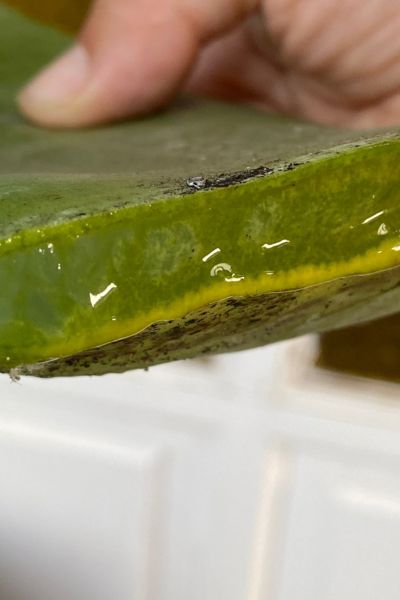
Integrating Aloe Vera into Your Everyday Life: Practical Suggestions
Aloe Vera Infused Water
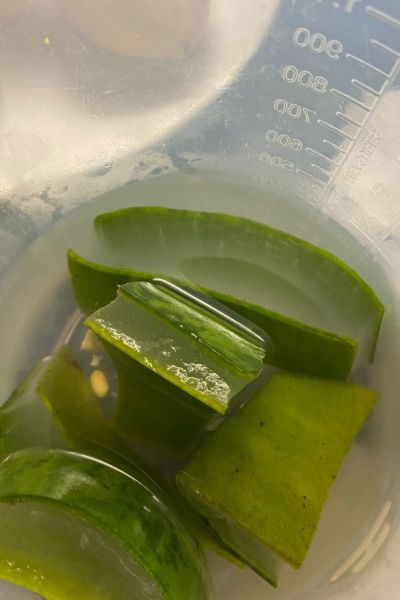
- Preparation of the Aloe Vera Leaf:
- Begin by cutting the Aloe vera leaf properly.
- Ensure to remove the aloin, the yellowish substance found just below the leaf’s skin. This is crucial as aloin can have strong laxative effects (it is very, very bitter!). Leave the leaf standing in a bowl of water overnight. See the picture above. In the morning, remove this water completely.
- Soaking for Further Aloin Removal:
- Once the aloin is removed, add water again and leave for an extra 2-4 hours. Change the water regularly if possible.
- Now, remove the water again, and you can cut the leaves into smaller pieces (leave the skin on).
- Place these pieces in a container filled with fresh, filtered water.
- Please in the fridge.
- Consumption:
- Later that day or the next day, you’ll have Aloe vera-infused water ready.
- Drink this water throughout the day to enjoy the benefits of Aloe vera.
This method allows you to harness Aloe vera’s hydrating and nutritional properties in a refreshing drink, minus the strong effects of aloin.
Aloe Vera in Your Diet: Fresh and Nutritious
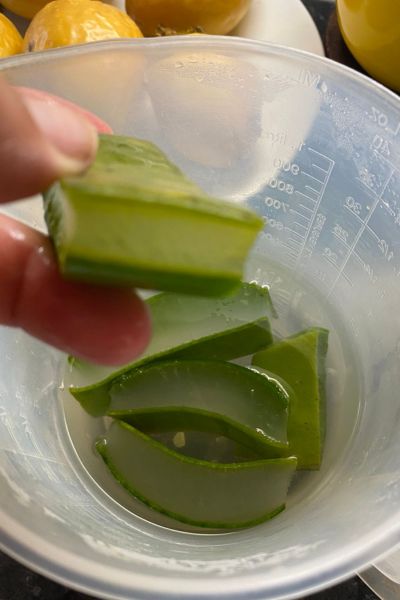
- Reusing the Soaked Aloe Vera Pieces:
- After infusing water with Aloe vera, don’t discard the soaked pieces. These can be repurposed for culinary uses.
- Preparation for Culinary Use:
- Start by peeling the soaked Aloe vera pieces. This involves removing the outer layer of the leaf to reveal the clear inner gel.
- Using a spoon, gently scoop out the gel.
- Incorporating into Salads:
- Cut the scooped Aloe vera gel into small, bite-sized pieces.
- These pieces can be added to salads, providing a refreshing and slightly gelatinous texture. They pair well with citrus fruits like oranges or grapefruits, mixed greens, and a light vinaigrette.
Creative Culinary Uses for Aloe Vera Gel
Aloe vera’s subtle flavour and unique texture make it a versatile addition to various dishes.
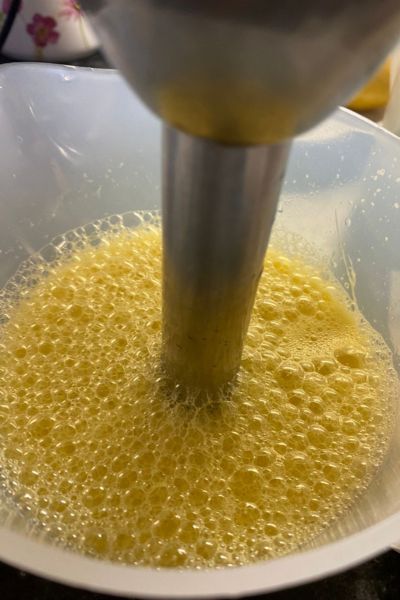
Here are some innovative ways to incorporate this nutritional powerhouse into your meals:
- Aloe Vera Smoothies:
- Refreshing Blend: Combine Aloe vera gel with fruits like pineapple, cucumber, and a hint of mint. This mix creates a revitalising smoothie that’s perfect for hot days.
- Tropical Delight: Mix Aloe vera gel with mango, coconut milk, and a splash of lime juice for a tropical treat.
- Aloe Vera Dressings:
- Citrusy Vinaigrette: Blend Aloe vera gel with lemon or lime juice, olive oil, a touch of honey, and fresh herbs like cilantro or parsley. Drizzle over salads or grilled vegetables for a zesty kick.
- Creamy Aloe Dressing: Mix Aloe vera gel with yoghurt, garlic, dill, and a squeeze of lemon. This creamy dressing pairs well with crisp greens or veggie dip.
- Aloe Vera Desserts:
- Fruit Bowls: Add bite-sized pieces of Aloe vera gel to fruit bowls. They complement berries, melons, and citrus fruits, providing an interesting texture amidst the fruity flavours.
- Aloe Jelly: Create a simple jelly using Aloe vera gel, agar-agar, and a sweetener of your choice. Serve chilled with a sprinkle of shredded coconut or fruit slices.
- Aloe Puddings: Blend Aloe vera gel with coconut milk, chia seeds, and a dash of vanilla. Let it set overnight for a creamy, nutritious pudding.
- Aloe Vera Sides:
- Aloe Salsa: Mix finely chopped Aloe vera gel with diced tomatoes, onions, cilantro, lime juice, and a pinch of salt for a refreshing salsa. Serve with tortilla chips or as a topping for grilled veggies.
- Aloe Pickle: Marinate Aloe vera pieces in a mixture of vinegar, salt, spices, and herbs. Store in a jar and enjoy as a tangy accompaniment to meals.
Incorporating Aloe vera into your culinary creations not only enhances the nutritional value of your dishes but also introduces an element of novelty and excitement to everyday meals.
Aloe Vera Flavor Enhancement Tip
Aloe vera has been traditionally used in various culinary applications, not just for its health benefits but also for its potential to enhance the flavor of certain dishes. For instance:
- Pomegranate Arils Preservation: A study titled “Application of Aloe vera Gel Coating Enriched with Cinnamon and Rosehip Oils to Maintain Quality and Extend Shelf Life of Pomegranate Arils” suggests that Aloe vera, when combined with cinnamon oil, can help in retaining the quality attributes of pomegranate arils. This indicates that Aloe vera might have a complementary effect on the flavor profile of pomegranate, making it a suitable ingredient for salads, desserts, and beverages.
- Aloe Vera Drinks with Moringa: Another study titled “Standardization of Recipe of Value-Added Functional Aloe Vera Drink Enriched with Moringa Leave” explored the formulation of Aloe vera drinks using different levels of moringa leaf extract. The results showed that the drink’s sensory attributes, including flavor, were positively influenced by the addition of Aloe vera.
While these studies provide insights into the potential flavour-enhancing properties of Aloe vera, it’s essential to note that individual taste preferences may vary. When incorporating Aloe vera into dishes, it’s always a good idea to start with a small amount and adjust according to taste.
Remember, while Aloe vera offers numerous health benefits, it’s crucial to ensure that the Aloe vera used in culinary applications is food-grade and free from harmful compounds like aloin. Always consult with a healthcare professional before making significant changes to your diet.
Conclusion
Aloe vera, often dubbed the “plant of immortality,” has been revered for millennia for its soothing properties and impressive nutritional profile.
As we’ve journeyed through its rich tapestry of vitamins and minerals, it’s evident that this humble succulent offers more than meets the eye.
Whether you’re applying its gel to soothe a burn or incorporating it into your diet, Aloe vera stands as a testament to nature’s ability to nurture and heal.
As with any natural remedy, moderation is key. Always consult with a healthcare professional before making significant changes to your diet or wellness routine.
Embrace the natural goodness of Aloe vera and let it be a beacon of health and vitality in your life.
I most definitely have.
